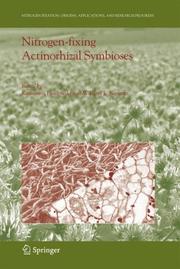| Listing 1 - 3 of 3 |
Sort by
|
Book
ISBN: 012633210X Year: 1990 Publisher: San Diego (Calif.) : Academic press,
Abstract | Keywords | Export | Availability | Bookmark
 Loading...
Loading...Choose an application
- Reference Manager
- EndNote
- RefWorks (Direct export to RefWorks)
Book
ISBN: 8770011788 Year: 1987 Publisher: Copenhagen : E. Munksgaard,
Abstract | Keywords | Export | Availability | Bookmark
 Loading...
Loading...Choose an application
- Reference Manager
- EndNote
- RefWorks (Direct export to RefWorks)
Actinorhizal plants --- Frankia --- Meetings --- Nitrogen fixing bacteria --- Actinorhizal plants --- Frankia --- Meetings --- Nitrogen fixing bacteria

ISBN: 1281130168 9786611130169 1402035470 1402035403 9048168953 Year: 2008 Volume: v. 6 Publisher: Dordrecht ; London : Springer,
Abstract | Keywords | Export | Availability | Bookmark
 Loading...
Loading...Choose an application
- Reference Manager
- EndNote
- RefWorks (Direct export to RefWorks)
This book is the self-contained sixth volume of a comprehensive series on nitrogen fixation. It presents the state-of-the-art in regards to actinorhizal symbioses. Like legumes, actinorhizal plants form root nodules that host nitrogen-fixing soil bacteria. However, because the macrosymbionts are, with one exception, woody plants rather than crop plants, actinorhizal symbioses are less well-known than legume symbioses to which they are phylogenetically related. Actinorhizal plants come from eight different families. They can grow on marginal soils by virtue of these symbioses and are used extensively in reforestation, soil reclamation, and desert agroforestry. The diversity of the involved host plants poses a variety of challenges to the actinorhizal symbiosis and results in interesting strategies, for example, to cope with the O2 dilemma or nutrient exchange between plant and bacterium. The actinorhizal micro-symbionts are Gram-positive actinomycetes of the genus Frankia. The inability to culture several actinorhizal microsymbionts has led to the development of diverse molecular strategies for strain identification. This volume includes chapters that deal with all these aspects of the symbiosis and both symbionts plus their ecological role and use. Other chapters tackle the global distribution of different actinorhizal plants and their microsymbionts and how this impacts the question of co-evolution of the micro- and macrosymbionts as well as comparing the actinorhizal and leguminous symbioses. No other book provides the up-to-date and in-depth coverage of this volume, which is intended to serve as an indispensable reference work for academic, governmental, and industrial scientists working in this area, to introduce students to the global importance of this association, and to provide science administrators with ready access to vital relevant information.
Actinorhizal plants. --- Nitrogen --- Nitrogen-fixing microorganisms. --- Symbiosis. --- Fixation. --- Biological nitrogen fixation --- Bionitrogen fixation --- BNF (Biological nitrogen fixation) --- Dinitrogen fixation --- Fixation of nitrogen --- Nitrogen fixation --- Biogeochemical cycles --- Consortism --- Biology --- Symbiogenesis --- Micro-organisms, Nitrogen-fixing --- Microorganisms --- Actinorrhizal plants --- Nitrogen-fixing plants --- Botany. --- Life sciences. --- Agriculture. --- Plant Sciences. --- Life Sciences, general. --- Farming --- Husbandry --- Industrial arts --- Life sciences --- Food supply --- Land use, Rural --- Biosciences --- Sciences, Life --- Science --- Botanical science --- Phytobiology --- Phytography --- Phytology --- Plant biology --- Plant science --- Natural history --- Plants --- Plant science. --- Floristic botany
| Listing 1 - 3 of 3 |
Sort by
|

 Search
Search Feedback
Feedback About UniCat
About UniCat  Help
Help News
News